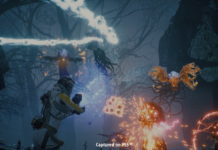Desirable disasters strike in Disaster Report
Where can you experience the thrill of an earthquake without
suffering any real-life consequences? In Disaster Report, a new and unique
title from Agetec and Irem Software.
Disasters are pretty common in games these days. Villains try to take over the
world; lives are destroyed; and whether there’s a happy ending or not, you know
you’ll see a lot of explosions along the way.
Irem didn’t want that. Best
known for developing the greatest side-scrolling shooter on the planet (R-Type),
Irem Software set out to develop a different kind of game, one that would it
provide its players with a one-of-a-kind experience that challenged the mind.
They succeeded, and the
results are quite impressive. Disaster Report exchanges weapons, monsters and
hand-to-hand combat for clever and unique puzzles and intense scenarios that are
built around a large, well-designed city. When the game begins, you find that
an immense earthquake has hit the city. Some of the city is still in one piece,
but it slowly falls apart as you explore and attempt to escape.
GameZone braved the
dangerous, crumbling city streets, evaded a falling street light and crossed a
dangling bridge to bring you an interview with the game’s director and producer,
Kazuma Kujo.
Question: What sort of
disasters will players have to overcome?
Kazuma Kujo: The most common
types of disasters players encounter during the game are earthquakes and
aftershocks. They must work with others to survive these events and their
aftermath. This includes avoiding collapsing buildings and escaping fires and
floods.
|
|
One wrong move and you’ll be
swimming with the fishies!
Q: Was any research done to
ensure that Disaster Report is as realistic as possible? Did the developers
visit any real-life disaster sites?
KK: We collected information
from various books and photos and also spent time speaking with survivors of
natural disasters. We didn’t visit any real-life disaster sites.
Q: About how long does the
"disaster" last? Most survival games are developed to be short but sweet,
providing months of replay value. Was Disaster Report developed with that
mantra?
KK: We wanted to capture
realistic human emotions of suspense, fear, and the thrill of "not knowing when
the next one will hit." Each disaster is short, but deadly, and is often the
precursor to an interactive event. For example, during an amusement park scene,
an aftershock causes the Ferris wheel to break apart. The wheel begins rolling
toward the player, eventually crushing them if they move too slowly. When
designing Disaster Report, our goal was to recreate situations that could be
believed to really happen during a widespread disaster, I think we succeeded.
Q: The rumble feature of the
Dual-Shock 2 controller is used quite extensively in the demo I previewed. The
force-feedback effects were very impressive. How much is the force-feedback
feature used in the final version, and in what ways?
|
|
Moments like these are some
of the most exciting in the game
KK: The "S-FORCE" sound tool
is used for things such as a person’s footsteps, the rending noise that
accompanies the collapse of steel buildings, blazing fires and even the sounds
of birds and cicadas. This system helps the player anticipate upcoming events
and has proven effective in settings where their visibility is limited. The
DUALSHOCK®2 and "S-FORCE" technology are a perfect combination. When used
together, interesting situations can be created. For example, the player is
walking toward a park and can hear birds chirping in the background; all of a
sudden they stop. Shortly after, a slight vibration is felt in the controller
that increases in intensity until, BANG, an earthquake hits.
Q: Disaster Report makes
very little use of power-ups and special items, the peanut butter and jelly of
most video games. Is there a reason for this?
KK: We didn’t want to
deviate from the real-life content and situations encountered in the game.
That’s why the main character is not a superman or hero, but just an everyday
sort of person. For this reason, the items that the player can use are limited
to those that exist in daily-life.
Q: The main goal of Disaster
Report is to get out alive, but the demo showed one scenario where you were
required to rescue a woman from a dangerous situation. Are there any other
objectives like that, or side quests to complete in Disaster Report?
KK: Yes, there are a few. Or
I should say, one progresses through the game by helping others and
incorporating teamwork to overcome obstacles. There are situations when the
player must make a conscious decision of where to go, whether or not they will
accompany someone, or if they will act in the interest of their own
self-preservation. Also, the main character is required to complete certain
tasks during the course of the game. Being the eager young reporter that he is,
he readily accepts.
|
|
Unlike Fear Factor, you’re
not just watching the action –
you get to participate in
it!
Q: How were the blurry
cinematic effects created?
KK: The scene I believe you
are referring to, the one with the surveillance camera, was created using the
synthesis of a graphics tool.
Q: What types of games would
you say influenced the development of Disaster Report the most?
KK: Movies and comics were
the major influence on the development team. For example, the movie Nihon-Chinbotsu
(Sinking Japan) and the comic Survival, by Mr. Take Saitoh, had the greatest
influence.
Q: How many real-time movie
sequences are being planned for the final version of the game? Will there be
multiple outcomes/endings to the story?
KK: There are more than 70
real-time movies in the final product and 7 different endings. All the movies in
the game are real-time, with the exception of the surveillance camera scene and
the scene where the main character regains consciousness in the bus after the
opening movie.
|
|
I went through a similar
situation to bring you this interview.
No, really!
Q: Disaster Report is a very
unique game that appears to have been developed primarily for Japanese players.
What kind of marketing plan is being implemented to attract American gamers,
most of who are used to playing games with big guns and big buns?
KK: Even in Japan, a
mainstream action-adventure game in which the player (main character) carries
around water instead of an arsenal of weapons isn’t common. We couldn’t
anticipate how Japanese consumers would react to this new take on the genre.
However, in reality, gamers who purchased Disaster Report understood the unique
qualities and appreciated what we did. The situations in Disaster Report offer
gamers something different than the usual "run around with guns blazing" fare.
The player assumes the role of a modern day citizen and has to react to
dangerous situations as they might if they actually encountered them in
real-life. The concept, I believe, has a universal appeal.
After playing the final
version of the game, I have to agree.
Thank you for your time, Mr.
Kujo.
Click here for Louis’
Full Review of Disaster Report











